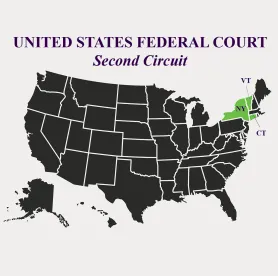A decision by a group of plaintiffs to seek review from the Supreme Court of the Second Circuit’s recent decision in Electra v. 59 Murray Enters., Inc., 987 F.3d 233 (2d Cir. 2021), highlights the role trademark law can play in protecting a celebrity’s identity or persona. When a celebrity’s image or likeness is used for commercial purposes without the celebrity’s consent, the celebrity will typically bring a misappropriation of likeness claim under state right of publicity laws. However, there is a lesser-known avenue to protect a celebrity’s image, which is to bring a claim for false endorsement under trademark law.
Trademark law protects individuals from the unauthorized use of their image or likeness even where the celebrity owns no trademark registration for his or her name, image, or likeness. The Lanham Act allows a plaintiff to bring a false endorsement claim against another person who uses “any word, name, term, symbol, or any combination thereof” that “is likely to cause confusion . . . as to the affiliation, connection or association” of the plaintiff with such person or “as to the origin, sponsorship or approval of” that person’s goods, services, or commercial activities. 15 U.S.C. § 1125(a)(1).
Some courts have limited false endorsement claims to plaintiffs who have achieved some level of “public recognition” or “fame.” The Electra plaintiffs have argued that the Second Circuit has adopted this “public recognition” or “fame” standard and are seeking to challenge this standard at the Supreme Court.
The Electra Case
The Electra plaintiffs—a group of professional models, actresses, and businesswomen who appeared in a variety of commercial, promotional campaigns, and magazines—brought suit against the owners of various New York City-based strip clubs that used the plaintiffs’ images to promote the clubs’ businesses. The clubs never sought plaintiffs’ permission to use the images and none of the plaintiffs agreed to appear in the clubs’ promotional content.
The plaintiffs’ causes of action included false endorsement claims: the plaintiffs alleged that the clubs’ use of the plaintiffs’ images falsely conveyed their endorsement or approval of the clubs’ services.
The district court rejected most of the plaintiffs’ false endorsement claims on grounds that the plaintiffs had not put forward proof that they had attained public recognition. Without some level of recognition, the court found, there was no basis for inferring confusion regarding the sponsorship or approval of the clubs’ goods or services.
This fact, in combination with the absence of admissible evidence of actual confusion and defendants’ lack of bad faith, led the court to conclude that consumers were unlikely to view the clubs’ use of the plaintiffs’ images as plaintiffs’ endorsement or sponsorship of the clubs’ goods and services.
The district court’s conclusion did not apply, however, to plaintiff Carmen Electra who had demonstrated her celebrity status through her starring roles in popular movies and television shows, by recording and releasing an album, and becoming a published author.
Plaintiffs appealed the district court’s decision to the Second Circuit. On the false endorsement claim, the panel endorsed the lower court’s analysis, including the trial court’s analysis of each of the plaintiff’s public prominence (or lack thereof), and affirmed the district court’s judgment.
On the point of public recognition, the Second Circuit reasoned that misappropriation of an “anonymous face” cannot form the basis for a false endorsement claim because the consuming public will not infer that an unknown model was endorsing a product. Rather, consumers will infer that the anonymous model merely lent her image to the company for a fee.
The plaintiffs filed a petition for a writ of certiorari to the Supreme Court arguing that the district court and Second Circuit’s reliance on whether plaintiffs proved “public recognition” imposed an extra-statutory burden on the plaintiffs. The plaintiffs’ have cast the Second Circuit’s decision as fundamentally altering the standing requirements for false endorsement claims under the Lanham Act.
The plain text of the Lanham Act allows “any person who believes he or she is likely to be damaged” by another’s use of a trademark or false or misleading representation to bring a false endorsement claim. By requiring a certain level of fame, plaintiffs argue that the Second Circuit has imposed an additional standing requirement that does not apply to other trademark holders who must demonstrate only that they made commercial use of the mark (not that the mark has become famous or is widely recognized).
Notably, the Electra plaintiffs also filed misappropriation of likeness claims under New York’s right of publicity statute. These claims were, however, rejected by the district court on summary judgment because the claims either fell outside the one-year statute of limitations or failed because the plaintiffs signed agreements releasing their rights to the images at issue.
On appeal, the Second Circuit largely agreed with the district court on the right of publicity claims except that, for two plaintiffs, the panel found that there were disputed questions of material fact as to the terms of these plaintiffs’ releases. The Second Circuit vacated the district court’s judgment for these two plaintiffs and remanded. The plaintiffs’ misappropriation claims are not the subject of plaintiffs’ petition for certiorari.
Considerations for Bringing Right of Publicity and False Endorsement Claims
The Electra case highlights a few important procedural, remedial, and potentially substantive distinctions between right of publicity claims, on the one hand, and false endorsement claims under the Lanham Act, on the other.
The most critical distinction for many of the Electra plaintiffs is the statute of limitations. In New York, right of publicity claims are subject to a one-year statute of limitations. In contrast, the Lanham Act has no statute of limitations; rather, federal courts look to analogous state laws to determine whether a Lanham Act claim is barred under the doctrine of laches. In New York, the most relevant analogous state law is the state’s six-year fraud statute.
There are also remedial distinctions between right of publicity claims and false endorsement claims. Because right of publicity is a matter of state law, the remedies available to plaintiffs vary by state and can include injunctive relief, statutory damages, compensatory damages, punitive damages, and/or attorney’s fees and costs. In New York, the right of publicity statute permits injunctive relief, compensatory damages, and, if the use of the individual’s name, portrait, or picture was “knowing,” exemplary damages. The statute does not provide recovery for the prevailing party’s attorney’s fees.
The Lanham Act similarly provides for injunctive relief, but it contains a different damages scheme: plaintiffs may recover defendant’s profits, the damages sustained by the plaintiff, and the costs of the action, subject to the principles of equity and the discretion of the court “according to the circumstances of the case.” 15 U.S.C. § 1117(a). Punitive damages are not available under the Lanham Act (though they may be available under state law causes of action) and a court may award reasonable attorney’s fees only in exception cases, such as where the conduct was malicious, fraudulent, deliberate, or willful.
Finally, there is potentially an important substantive distinction between right of publicity claims and false endorsement claims. If, as the Electra plaintiffs argue, false endorsement claims require a showing of “fame” or “public recognition,” this is a requirement that is not present in New York’s right of publicity statute. And, as discussed more below, “fame” is not a requirement in traditional trademark infringement claims. Indeed, this last point goes to the heart of the Electra plaintiffs’ petition for certiorari.
Celebrity Image and Trademark Law
Although it is possible to obtain a trademark registration for a celebrity’s name, image, or likeness, historically it has been somewhat difficult to do. This is because the USPTO requires that a trademark application feature a mark that is limited to a particular aspect of the celebrity’s persona—such as the celebrity’s name or a specific depiction of the celebrity’s image—and cannot claim a general reference to the person’s “identity” or “persona.”
In addition, the celebrity’s name or image must function as a trademark: it must identify the source of goods and services listed in the application. For example, Hailey Bieber applied to register her name as a trademark in 2018 based on an intent to use the mark in connection with clothing. U.S. Trademark Application Serial No. 88-149,810. Although the USPTO allowed the mark, the application was ultimately abandoned when no statement of use was provided showing the mark was used in connection with the listed goods.
More recently, celebrities have been able to acquire trademark registrations for elements of their persona for generalized endorsement and sponsorship services. For example, Usain Bolt obtained a registration for a silhouette of his image standing in his “lightning bolt” pose for use in connection with “personal appearances by a sports celebrity.” U.S. Registration No. 4,069,022. Kim Kardashian obtained several registrations for her name for use in connection with, among other things, endorsement services and personal appearances by a media celebrity, model, and actress. See, e.g., U.S. Registration Nos. 3,371,751 and 4,516,079. And Colin Kaepernick has applied to register an image of a bust of his neck, face, hair, and beard in connection with a wide array of goods and services. U.S. Trademark Application Serial No. 88-144,667.
False endorsement claims treat the plaintiff’s identity or persona as a “trademark” (even if no mark has been registered with the USPTO). And courts analyze a false endorsement claim like they would a traditional trademark infringement claim: courts consider the likelihood of confusion factors that apply in trademark infringement cases, albeit modified slightly to omit factors that are inapplicable to false endorsement claims.
Although the likelihood of confusion factors vary between circuits, the Second Circuit’s likelihood of confusion factors provide a good example for purposes of analysis. These factors are: (1) strength of the trademark, (2) evidence of actual consumer confusion, (3) evidence that the imitative mark was adopted in bad faith, (4) similarity of the marks, (5) proximity of the products and their competitiveness with one another, (6) sophistication of consumers in the relevant market, (7) the likelihood that the owner of the mark will bridge the gap, and (8) the quality of the defendant’s product. In false endorsement cases, courts in the Second Circuit often omit the last two factors because they do not apply to such cases.
The Electra plaintiffs’ primary concern in their petition for certiorari is that the district court and Second Circuit transformed the first factor—the strength of the mark—into a dispositive factor that effectively makes “celebrity” or “fame” a threshold requirement, rather than merely one of many factors that inform the court’s likelihood of confusion analysis.
If, as the plaintiffs argue, “celebrity” or “fame” has become a threshold issue in false endorsement claims, this approach stands in stark contrast to the showing plaintiffs must make in more traditional trademark infringement claims. In a typical trademark infringement claim, plaintiffs need only show that they own a trademark, that they have used the mark on goods and service in commerce, and that confusion is likely.
Similarly, to register a trademark with the USPTO, applicants need only show that the mark is used in commerce, not that it has reached some level of public recognition or fame. In other words, the law allows for the protection of a mark regardless of whether the mark has become “famous” or achieved widespread recognition.
The Electra plaintiffs would have likely easily met this lower threshold: there was evidence before the district court that the plaintiffs had engaged in commercial use of their image.
As the Electra plaintiffs point out in their petition, trademark law also already provides separate protection for famous marks through causes of action for trademark dilution. Owners of famous trademarks may bring suit against others whose use of similar marks impairs the distinctiveness or reputation of the famous mark. Because Congress has carved out protections for famous marks, courts should not read a separate and additional “fame” or “recognition” requirement into false endorsement claims.
The Electra plaintiffs’ characterization of the district court’s and Second Circuit’s reasoning is, however, somewhat overstated. As the defendants in Electra argued in their opposition brief, both the district court and Second Circuit considered the strength-of-the-mark factor along with the other likelihood of confusion factors.
In particular, the district court addressed actual confusion and bad faith in separate sections in its opinion, and the court summarily addressed the remaining likelihood of confusion factors. In the Second Circuit’s decision, the panel similarly addressed the strength of the mark, actual confusion, and the defendants’ bad faith. As such, there is an argument that the Second Circuit has not created a new standing requirement for false endorsement claims; rather, it applied the likelihood of confusion factors as it was required to do under applicable precedent and believed the strength-of-the-mark factor weighed most heavily in this case.
More generally, the Second Circuit’s view is also consistent with the purpose behind endorsements. When a brand seeks a celebrity endorsement, it hopes to capitalize on the celebrity’s recognition and reputation among the consuming public. If the public is not able to recognize an individual by their image, then can the public be confused as to whether the unidentified person endorses the brand’s goods or services?
For the Second Circuit, the answer to this question is clearly “no” and we will see if the Supreme Court will weigh in on the issue.






 />i
/>i

